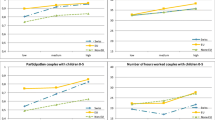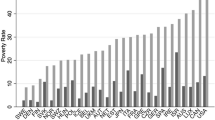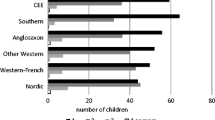Abstract
This paper tests the contribution of increased labor market participation to a substantial narrowing of the gap in material welfare between two parent and single mother households in Russia in the period 1996–2003. Decomposition analysis employing the technique of Juhn et al. (Accounting for a slowdown in black–white wage convergence, Kosters (ed), 1991) and data from the Russian Longitudinal Monitoring Survey shows that increased labor market participation explains about one-third of the narrowing of the welfare gap. Changes in the regional distribution of single mother households, specifically increasing concentration in Moscow and St Petersburg, have proved critical because of the higher wages available in these cities. Thus quality of employment has been as important as increased participation in the labor market.
Similar content being viewed by others
Notes
Author’s calculations using data from the RLMS.
When single mother poverty rates declined in the USA they remained substantially higher (by 28.5% points in 2003) than for households with two co-resident parents. In 1996 the poverty rate for married couple families with children was 7.5%, compared with 42% for female householder households with children and by 2003 the rate for married couple families with children had fallen slightly to 7% and that of female householders had fallen to a greater degree to 35.5% (US Census Bureau 1991; 2004).
Author’s calculations from the RLMS.
Part of the effects of the regional and urban-PGT-rural variables is attributable to differences in prices between the regions, which may exaggerate differences in living standards between regions.
References
Alexandrova, A., & Grishina, E. (2007). Who receives targeted benefits in transition? The effect of household characteristics on take-up rates in Russia’s child allowance programme. Social Policy and Society, 6, 141–150.
Ashwin, S., & Bowers, E. (1997). Do Russian women want to work? In M. Buckley (Ed.), Post-Soviet women: From the Baltic to central Asia (pp. 21–37). Cambridge, England: Cambridge University Press.
Berger, M. C., Blomquist, G. C., & Peter, K. C. (2008). Compensating differentials in emerging labour and housing markets: Estimates of quality of life in Russian cities. Journal of Urban Economics, 63, 25–55.
Blau, F. D., & Kahn, L. M. (1997). Swimming upstream: Trends in the gender wage differential in the 1980 s. Journal of Labor Economics, 15, 1–42.
Blinder, A. S. (1973). Wage discrimination: Reduced form and structural estimates. Journal of Human Resources, 8, 436–455.
Brainerd, E. (1998). Winners and losers in Russia’s economic transition. The American Economic Review, 88, 1094–1116.
Brainerd, E. (2000). Women in transition: changes in gender wage differentials in Eastern Europe and the former Soviet Union. Industrial and Labor Relations Review, 54, 138–162.
Bronson, D. E., Kunovich, S., & Frysztacki, K. (2005). The impact of the economic transition in Poland on vulnerable populations. Journal of Family and Economic Issues, 26, 225–238.
Buckley, R., & Gurenko, E. (1997). Housing and income distribution in Russia: Zhivago’s legacy. World Bank Research Observer, 12, 19–32.
Burawoy, M., & Verdery, K. (1999). Introduction. In M. Burawoy & K. Verdery (Eds.), Uncertain transition: Ethnographies of change in the postsocialist world (pp. 1–19). Lanham, MD: Rowman & Littlefield.
Chaudhuri, A. (2009). Spillover effects of a reproductive health program on elderly women in rural Bangladesh. Journal of Family and Economic Issues, 30, 113–125.
Cheidvasser, S., & Benítez-Silva, H. (2007). The educated Russian’s curse: Returns to education in the Russian Federation. Labor, 21, 1–41.
Clarke, S., Varshavskaya, L., Alasheev, S., & Karelina, M. (2000). The myth of the urban peasant. Work, Employment and Society, 14, 481–499.
Danziger, S., Gottschalk, P., & Smolensky, E. (1989). How the rich have fared 1973–1987. American Economic Review, 79, 310–314.
Denisova, I., Kolenikov, S., & Yudaeva, K. (2000). Child benefits and child poverty. CEFIR Working Paper. Retrieved July 16, 2009, from http://www.cefir.org/index.php?l=eng&id=35&yf=2000.
Desai, P., & Idson, T. (2000). Work without wages: Russia’s nonpayment crisis. Cambridge, MA: MIT Press.
Earle, J., & Sabirianova, K. (2002). Understanding wage arrears in Russia. Journal of Labor Economics, 20, 661–707.
Falkingham, J., & Kanji, S. (2000). Measuring poverty in Russia: A critical review. Report prepared for the United Kingdom Department for international development. Retrieved on July 16, 2009, from www.dfid.gov.uk/pubs/files/russia-lse.pdf.
Flemming, J., & Micklewright, J. (2000). Income distribution, economic systems and transition. In A. B. Atkinson & F. Bourguignon (Eds.), Handbook of income distribution (pp. 843–918). Amsterdam: North-Holland.
Forry, N. D. (2009). The impact of child care subsidies on low-income single parents: An examination of child care expenditures and family finances. Journal of Family and Economic Issues, 30, 43–54.
Gerber, T. P. (2000). Educational stratification in contemporary Russia: Stability and change in the face of economic and institutional crisis. Sociology of Education, 73, 219–246.
Gerry, C. J., Nivorozhkin, E., & Rigg, J. (2008). The great divide: Ruralisation of poverty in Russia. Cambridge Journal of Economics, 32, 593–607.
Glinskaya, E., & Mroz, T. A. (2000). The gender gap in wages in Russia from 1992 to 1995. Journal of Population Economics, 13, 353–386.
Goskomstat. (1999). Sotsialnoe polozhenie i uroven zhizni naseleniia Rossii: Statisticheskii sbornik (Social conditions and standard of living of the population of Russia: Statistical collection). Moscow: Goskomstat Rossii.
Goskomstat. (2002). Sotsialnoe polozhenie i uroven zhizni naseleniia Rossii: Statisticheskii sbornik (Social conditions and standard of living of the population of Russia: Statistical collection). Moscow: Goskomstat Rossii.
Goskomstat. (2007). Sotsialnoe polozhenie i uroven zhizni naseleniia Rossii: Statisticheskii sbornik (Social conditions and standard of living of the population of Russia: Statistical collection). Moscow: Goskomstat Rossii.
Grootaert, C., & Braithwaite, J. (1998). Poverty correlates and indicator-based targeting in Eastern Europe and the Former Soviet Union. World Bank Policy Research Working Paper No. 1942.
Heckman, J. J. (1979). Sample selection bias as a specification error. Econometrica, 47, 153–161.
Herbst, C., & Barnow, B. (2008). Close to home: A simultaneous equations model of the relationship between child care accessibility and female labor force participation. Journal of Family and Economic Issues, 29, 128–151.
Hofferth, S. (2002). Did welfare reform work? Implications for 2002 and beyond. Contexts, 1, 45–51.
Issoupova, O. (2002). Nedostatochno oplachivaemaia rabota: Pochemu my soglashaemsia? (Low pay for the job. Why do we agree?). Sotsiologicheskie Issledovaniia, 3, 62–72.
Juhn, C., Murphy, K., & Pierce, B. (1991). Accounting for a slowdown in black-white wage convergence. In M. H. Kosters (Ed.), Workers and their wages (pp. 107–143). Washington DC: AEI Press.
Kanji, S. (2004). The route matters: Poverty and inequality among lone-mother households in Russia. Feminist Economics, 10, 207–225.
Klugman, J., & Kolev, J. (2001). Mobility and poverty dynamics among Russian children. In B. Bradbury, S. P. Jenkins, & J. Micklewright (Eds.), The dynamics of child poverty in industrialised countries (pp. 255–275). Cambridge, United Kingdom: Cambridge University Press.
Knijn, T., Martin, C., & Millar, J. (2007). Activation as a common framework for social policies towards lone parents. Social Policy and Administration, 41, 638–652.
Kolenikov, S., & Shorrocks, A. (2005). A decomposition analysis of regional poverty in Russia. Review of Development Economics, 9, 25–46.
Lehmann, H., Wadsworth, J., & Acquisti, A. (1999). Grime and punishment: Job insecurity and wage arrears in the Russian Federation. Journal of Comparative Economics, 27, 595–617.
Lichter, D. T., & Crowley, M. (2004). Welfare reform and child poverty: Effects of maternal employment, marriage, and cohabitation. Social Science Research, 33, 385–408.
Livermore, M., Powers, R. S., Creel Davis, B., & Lim, Y. (2010). Failing to make ends meet: Dubious financial success among employed former welfare to work participants. Journal of Family and Economic Issues. doi:10.1007/s10834-010-9192-5.
Lokshin, M. (2004). Household childcare choices and women’s work behavior in Russia. Journal of Human Resources, 39, 1094–1115.
Lokshin, M., Harris, K. M., & Popkin, B. M. (2000). Single mothers in Russia: Household strategies for coping with poverty. World Development, 28, 2183–2198.
Lokshin, M., & Popkin, B. M. (1999). The emerging underclass in the Russian Federation: Income dynamics 1992–96. Economic Development and Cultural Change, 47, 803–829.
Malone, K., Stewart, S. D., Wilson, J., & Korsching, P. F. (2010). Perceptions of financial well-being among American women in diverse families. Journal of Family and Economic Issues, 31, 63–81.
Mammen, S., Lass, D., & Seiling, S. B. (2009). Labor force supply decisions of rural low- income mothers. Journal of Family and Economic Issues, 30, 67–79.
Mikhalev, V. (1997). Poverty alleviation in the course of transition: Policy options for Russia. Working Paper. Florence: European University Institute.
Millar, J. (2008). Work is good for you. Lone mothers children, work and wellbeing. Social Security and Health Research Working Papers, 60/2008 Kela Research Department.
Mokhtari, M., & Asgary, N. (2009). Effects of consumer goods shortages on fertility in post-Soviet economy. Journal of Family and Economic Issues, 30, 160–170.
Molina, J. A., & Montuenga, V. M. (2009). The motherhood wage penalty in Spain. Journal of Family and Economic Issues, 30, 237–251.
Mozhina, M. (1995). Uroven zhizni gorodskogo naselenia Rossii i sozialnie problemy reform. Moscow: ISESP, Intercentre.
Mroz, T., & Popkin, B. M. (1995). Poverty and the economic transition in the Russian Federation. Economic Development and Cultural Change, 44, 1–31.
Newell, A., & Reilly, B. (1996). The gender gap in Russia: Some empirical evidence. Labor Economics, 3, 337–356.
Newell, A., & Reilly, B. (1999). Rates of return to educational qualifications in the transitional economies. Educational Economics, 7, 67–84.
Oaxaca, R. L. (1973). Male-female wage differentials in urban labor markets. International Economic Review, 14, 693–709.
Ornacka, K., & Szczepaniak-Wiecha, (2005). The contemporary family in Poland: New trends and phenomena. Journal of Family and Economic Issues, 26, 195–224.
Philipov, D., & Shkolinkov, V. (2001). Fertility intentions and coping strategies: results from the Russian Longitudinal Monitoring Survey. Paper presented at the 2001 Annual. Meeting of the Population Association of America, Washington DC.
Popkin, B., Mozhina, M., & Baturin, A. (1992). The development of a subsistence income level in the Russian Federation. (Mimeo) Chapel Hill: Carolina Population Center, University of North Carolina.
Prokofieva, L., & Tersikh, L. (1998). Standards of living and family structure in a period of social transformation in the 1990 s. Population: An English Selection, 10, 483–494.
Ravallion, M., & Lokshin, M. (2006). Testing poverty lines. Review of Income and Wealth, 52, 399–421.
Reilly, B. (1999). The gender pay gap in Russia during the transition, 1992–1996. Economics of Transition, 7, 245–264.
Richter, K. (2006). Wage arrears and economic voting in Russia. American Political Science Review, 100, 133–145.
Rose, R., & McAllister, I. (1996). Is money the measure of welfare in Russia? Review of Income and Wealth, 42, 75–90.
Sawhill, I., & Haskins, R. (2002). Welfare reform and the work support system. Policy Brief No. 17, Welfare Reform and Beyond. Washington, DC: Brookings Institution.
Seeth, T. H., Chachnov, S., Surinov, A., & Von Braun, J. (1998). Russian poverty: Muddling through economic transition with garden plots. World Development, 26, 1611–1623.
Sicular, T., Ximing, Y., Gustaffson, B., & Shi, L. (2007). The urban-rural income gap and inequality in China. Review of Income and Wealth, 53, 93–126.
Standing, G. (1994). The changing position of women in Russian industry: Prospects of marginalization. World Development, 22, 271–283.
Tartakovskaya, I. (2000). The changing representation of gender roles in the Soviet and Post-Soviet press. In S. Ashwin (Ed.), Gender, state and society in Soviet and Post- Soviet Russia (pp. 118–136). London and New York: Routledge.
Tchernina, N. (1996). Economic transition and social exclusion in Russia. Geneva: International Institute for Labor Studies.
Tilly, C., & Albelda, R. (1994). Family structure and family earnings: The determinants of earnings differences among family types. Industrial Relations, 33, 151–167.
Urban, J., & Olson, P. (2005). A comprehensive employment model for low-income mothers. Journal of Family and Economic Issues, 26, 101–122.
U.S. Census Bureau. (2004). Current population survey. Annual social and economic supplements. Washington DC: Government Printing Office.
U.S. Census Bureau. Annual social and economic supplements. (1997). Current Population Survey. Washington DC: Government Printing Office.
Woodruff, D. (1998). Barter of the bankrupt: The politics of demonetization in Russia’s federal state. In M. Burawoy & K. Verdery (Eds.), Uncertain transition: tthnographies of change in the postsocialist world (pp. 83–124). Lanham, Maryland: Rowman and Littlefield.
World Bank. (1995). Poverty in Russia: An assessment. Washington, DC: World Bank.
World Bank. (2002). Russian Federation–child welfare outcomes during the 1990 s: The case of Russia. Washington, DC: World Bank.
Yemtsov, R. (2005). Quo vadis? : Inequality and poverty dynamics across Russian regions. In R. Kanbur & A. Venables (Eds.), Spatial inequality and development (pp. 348–408). Oxford, UK: Oxford University Press.
Author information
Authors and Affiliations
Corresponding author
Rights and permissions
About this article
Cite this article
Kanji, S. Labor Force Participation, Regional Location, and Economic Well-Being of Single Mothers in Russia. J Fam Econ Iss 32, 62–72 (2011). https://doi.org/10.1007/s10834-010-9198-z
Published:
Issue Date:
DOI: https://doi.org/10.1007/s10834-010-9198-z




